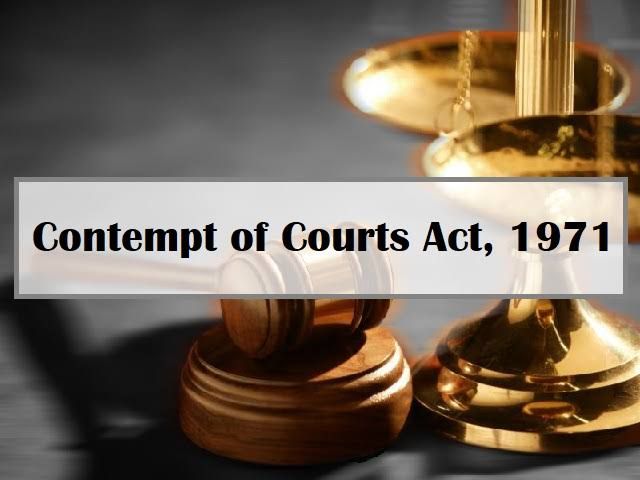Contempt of Court Act, 1971

Author Aditi Patil,DES Shri Navalmal Firodia Law College, Pune.
Introduction:
The judiciary in India, tasked with upholding justice and equality, stands as a cornerstone of the union government. Entrusted with the duty of dispensing justice, the judiciary plays a pivotal role in maintaining the sanctity of the constitution. Provisions under articles 129 and 215 empower the courts to hold individuals in contempt, safeguarding their authority against any attempts to demean or belittle. The legal landscape governing contempt in India has evolved through various legislations, with the current framework established by The Contempt of Courts Act, 1971, last amended in 2006.
Understanding Contempt of Court:
Commonly, ‘contempt of court’ refers to the act of lowering or defying the court’s authority by disobeying its instructions. The Contempt of Courts Act, 1971, provides the first formal definition of the term, categorizing it into ‘civil contempt’ and ‘criminal contempt.’ While civil contempt involves private wrongs that harm the interests of the affected party, criminal contempt is a societal misdeed where the contemnor undermines the court’s authority, bringing it disrepute.
Sections 2(b) and 2(c) of the Contempt Act meticulously differentiate civil and criminal contempt. Civil contempt encompasses wilful disobedience to court orders, while criminal contempt involves the publication of matter or acts that scandalize the court, interfere with judicial proceedings, or obstruct the administration of justice. The Calcutta High Court and the Allahabad High Court have further delineated the distinctions. Civil contempt aims to rectify wrongs done to a party, imposing sanctions, while criminal contempt seeks to punish those who dishonour the court, impeding the process of justice. Some cases, however, fall into neither category and are termed Sui Generis, involving impertinent behaviour with potential fines or imprisonment.
Historical Background of the Act:
The origins of contempt laws in India trace back to English laws and statutes. Until 1926, there were no statutory laws on contempt, and the legal principles were guided by British laws governing superior courts of record. The Contempt of Courts Act, 1926, marked the first statutory legislation, granting powers to High Courts to punish contempt’s of subordinate courts. However, it lacked provisions for contempt’s of courts subordinate to Chief Courts and Judicial Commissioner’s Court, leading to its repeal by The Contempt of Courts Act, 1952.
The Contempt of Courts Act, 1952, introduced no new powers but made notable changes, redefining ‘High Court’ and allowing them to try contempt’s subordinate to them. Ambiguity persisted around the term ‘contempt,’ and a committee was formed in 1961 under H.N. Sanyal to address this and align contempt laws with constitutional rights. The committee’s recommendations materialized in The Contempt of Courts Act, 1971, overhauling contempt laws in India.
Brief Overview of the Contempt of Courts Act:
Applicable to all of India, except Jammu and Kashmir in matters unrelated to the Supreme Court, the Act empowers certain courts to punish contempt of themselves and subordinate courts. With 24 sections, it covers the meaning of contempt, definitions of civil and criminal contempt, what constitutes contempt, defences available, extraterritorial jurisdiction of the High Court, their power to punish contempt’s of subordinate courts, and post-cognizance procedures.
The Contempt of Courts Act, 1971, underwent a crucial amendment in 2006, introducing the defence of truth under Section 13. This amendment aimed to balance court powers and fundamental rights, addressing potential arbitrariness in contempt proceedings. Section 13 allows the court to permit ‘justification by truth’ as a valid defence if it is in the public interest, and the request is bona fide.
Criticism:
Eminent legal figures, such as Fali Nariman, have criticized the contempt jurisdiction as “mercurial” with no rules or constraints. The Act’s ambiguity regarding what constitutes “scandalizing the court” has led to uncertainty. The definition might have evolved since 1971, creating a need for clearer guidelines. The offense of scandalizing the court remains subjective, lacking a precise framework for interpretation.
Conclusion:
While freedom of speech and expression, along with the right to personal liberty, are crucial, maintaining public faith in the judicial institution is equally vital. The judiciary, as the last bastion of the Rule of Law, must be revered with proper standards. The purposes of contempt laws, as laid down by the House of Lords, include facilitating litigation, enabling court trials without interference, and ensuring the maintenance of authority and administration of law.
Articles 19(1) (a) and 21 pose challenges to the legislation, questioning its constitutionality. However, Sections 13 and 16 of the Act bring balance by restricting the court’s powers and providing the defence of truth in contempt proceedings. Section 16 places judges and magistrates on an equal footing with ordinary individuals regarding contempt, ensuring accountability. Section 13 allows the defence of truth, prohibiting judges from charging contempt unless there is a substantial obstruction of justice.
While the legislation may have flaws, addressing the ambiguity around ‘scandalizing the court’ and ensuring clearer guidelines could enhance its effectiveness. The 2006 amendment was a step in the right direction, aligning the Act with constitutional principles. Preserving the dignity of the judiciary is imperative for a healthy, civilized society, and constant evaluation and refinement of contempt laws are necessary to achieve this delicate balance.


